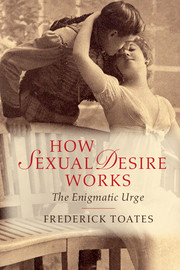Book contents
- Frontmatter
- Dedication
- Contents
- List of figures
- Preface
- One What is enigmatic about sexual desire?
- Two Explaining desire: multiple perspectives
- Three Sexual desire in a broad context
- Four An incentive-based model
- Five Sex and levels of organization
- Six Sexual attraction
- Seven Shades of desire from simple to complex
- Eight Details of the brain and desire
- Nine Arousal
- Ten The consequences of sexual behaviour and associated expectations
- Eleven Sexual familiarity and novelty
- Twelve Inhibition, conflict and temptation
- Thirteen How did sexual desire get here?
- Fourteen Setting the trajectory: link to adult sexuality
- Fifteen Sexual desire in interaction
- Sixteen Representations of sex
- Seventeen Sexual addiction
- Eighteen Variations in desire: general principles
- Nineteen Some forms of desire at the fringes
- Twenty The toxic fusion: violence and sexual desire
- Twenty one Sexually associated (serial) murder
- Twenty two Concluding remarks
- Notes
- References
- Index
Twenty - The toxic fusion: violence and sexual desire
Published online by Cambridge University Press: 05 October 2014
- Frontmatter
- Dedication
- Contents
- List of figures
- Preface
- One What is enigmatic about sexual desire?
- Two Explaining desire: multiple perspectives
- Three Sexual desire in a broad context
- Four An incentive-based model
- Five Sex and levels of organization
- Six Sexual attraction
- Seven Shades of desire from simple to complex
- Eight Details of the brain and desire
- Nine Arousal
- Ten The consequences of sexual behaviour and associated expectations
- Eleven Sexual familiarity and novelty
- Twelve Inhibition, conflict and temptation
- Thirteen How did sexual desire get here?
- Fourteen Setting the trajectory: link to adult sexuality
- Fifteen Sexual desire in interaction
- Sixteen Representations of sex
- Seventeen Sexual addiction
- Eighteen Variations in desire: general principles
- Nineteen Some forms of desire at the fringes
- Twenty The toxic fusion: violence and sexual desire
- Twenty one Sexually associated (serial) murder
- Twenty two Concluding remarks
- Notes
- References
- Index
Summary
But she hath lost a dearer thing than life,
And he had won what he would lose again;
This forced league doth force a further strife;
This momentary joy breeds months of pain;
This hot desire converts to cold disdain.
(Shakespeare, The Rape of Lucrece, lines 687–91)
Rapists come in different varieties with different underlying motivational dynamics (Hickey, 2010). Therefore, it is possible to present here a description in only very broad brushstrokes, highlighting certain features that might usually be present. Some rapes are planned well in advance and target a stranger, whereas others can be the sudden impulsive reaction to thwarting of the male’s goals towards a familiar woman, as in date rape. Some appear to be second best to consensual sex, where force is only instrumental to achieve the goal. For others, the element of coercion is an integral part of the desire. So, it appears that rape can serve goals in addition to sexual fulfilment (Marshall and Barbaree, 1990) and interactions of sexual desire with other motivations are evident. A desire for power and dominance can contribute to the motivation (Calhoun and Wilson, 2000). Some rapists use violence only to gain access to a woman, whereas for others the violence continues beyond this point suggesting fusion of sexual and aggressive motivations (Zillmann, 1984). Sadly, rape is evident across cultures, including even the sexually permissive land of Polynesian Mangaia (Marshall, 1971). Novelty, excitement and transgression doubtless often play a role. As the ex-wife of the British rapist known as the ‘monster of the M5’ expressed it (quoted by Apter, 2007, p. 152): ‘We always had a perfectly healthy sex life – but he always seemed to need that little bit of extra excitement, like a racing driver.’
What goes on in the brain of a rapist?
Hare (1993) estimates that one half of all repeat/serial rapists meet the criteria for being psychopaths. The non-psychopathic rapists would feel some guilt and remorse.
- Type
- Chapter
- Information
- How Sexual Desire WorksThe Enigmatic Urge, pp. 398 - 408Publisher: Cambridge University PressPrint publication year: 2014



